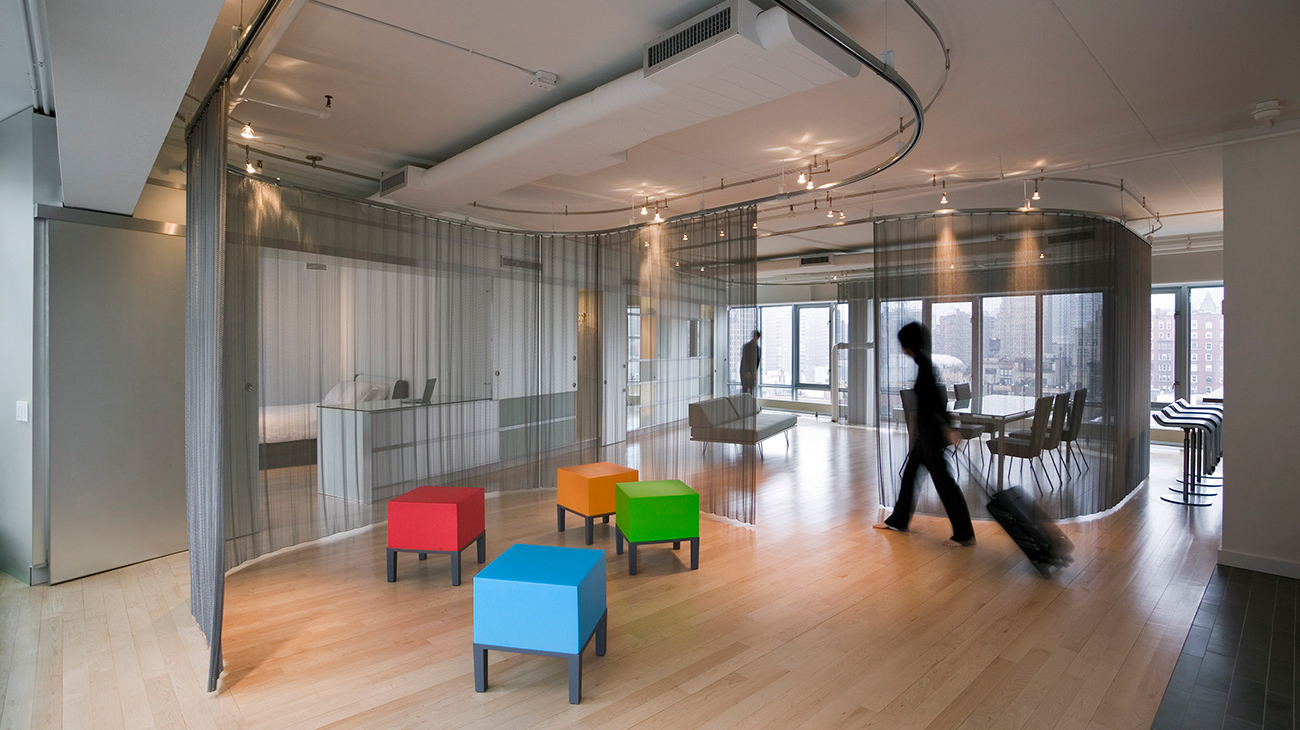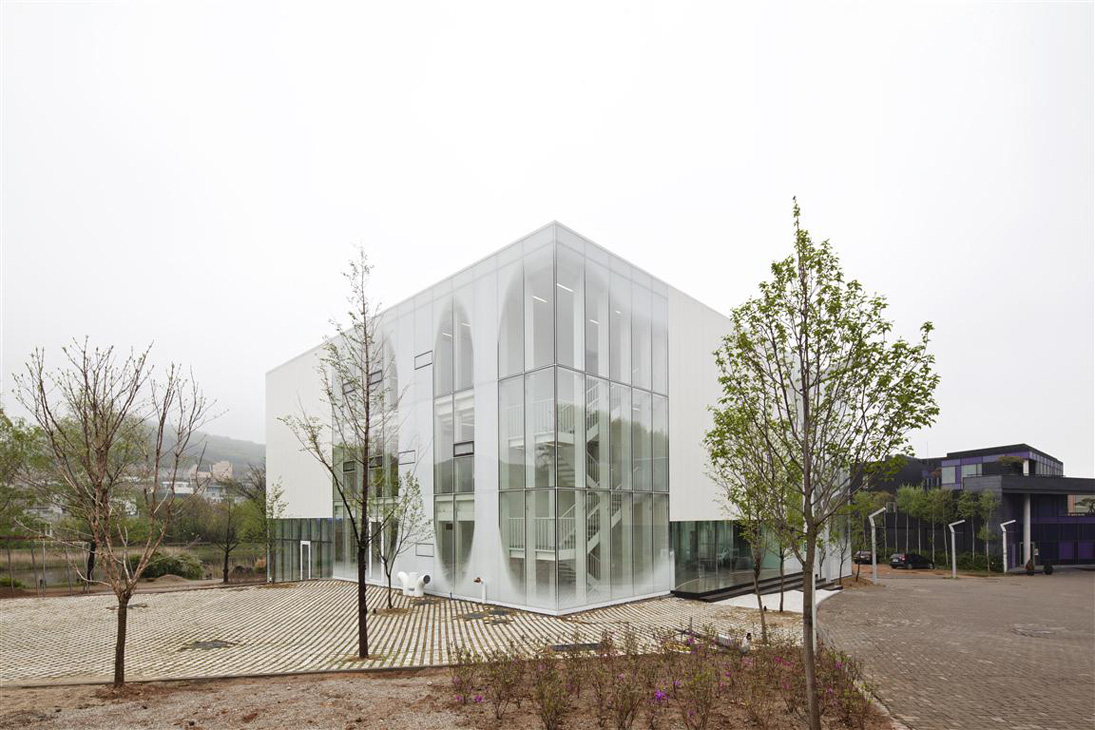SsD interview
John Hong and Jinhee Park of SsD discuss landscape, history, and social systems in architecture.
An interview with SsD, a 2012 Emerging Voice.
Jinhee Park and John Hong of SsD approach design as an interdisciplinary venture, simultaneously exploring aspects of architecture, landscape, history, and social systems. Among their recently completed projects are the White Block Gallery and “Cloud,” an interactive light and sound sculpture, both in Heyri, Korea; and the Braver house in Newton, Massachusetts. The firm, based in Cambridge, New York, and Seoul, also curated and designed the exhibition New Trajectories: Convergent Flux, Korea, first displayed at the Harvard Graduate School of Design.
Jinhee Park and John Hong sat down to discuss their work and what it means to be an Emerging Voice with Gabriel Silberblatt, the League’s Assistant Editor.
*
Gabriel Silberblatt, the Architectural League: As an emerging firm, what do you see as the advantages and challenges to practice in today’s economic, professional, and intellectual climate?
John Hong: You mean “today’s” today’s? As in, “the bad economy” today’s? After the global exuberance of the boom economy “local knowledge” is that much more important today. We have small “micro-offices” in New York, Cambridge, and Seoul. The formula works because it’s predicated on having very, very local knowledge, instead of being a firm that just goes around and does more kinds of general things. We can get very specific into the zoning and culture in each of the cities and become closer to the builders we work with. Ironically the global practice is, I think, more possible now because we feel more needed at the local level.
Jinhee Park: Also, because of the economy, people who are trying to do new projects are, in a way, more serious, more driven by their visions than by the goal of making profits. It enables us to develop the concept with the client at a very early stage, so in that sense, we’re more valuable to them. We’re not good at producing a lot stuff in a short amount of time, but we’re interested in creating a new concept with the client’s close involvement. That kind of working style is a better fit these days.
Hong: Should we talk about the challenges? We’ve been challenged even when the economic climate was really good; we’re actually doing better now than before. Is that worth talking about?
Anne Rieselbach, the Architectural League: Absolutely!
Hong: Jinhee put our office in economic recession in 2006. It was a conscious choice, because we were doing a lot of developer work at that time. In a very decisive way, we turned off all of those projects— about eight in total. We distributed them, or just quit if they were in schematics, because it was developing a culture in our office that we were uncomfortable with. With so much time involved, it was diverting the direction of the office. So we have have had this forced economic recession since 2006. But back to the advantage part: today, with the working methods we had time to set up in a very deliberate way, a lot of that is now coming to fruition.
Silberblatt: This lecture and prize series specifically emphasizes “voice.” We’d like to know how you describe your “voice.”
Hong: In the office, we’re always talking about practicing in a way that is, not just “multidisciplinary,” but looking at a set of ideas simultaneously. I think this convergent approach leads to work that we hope to be prototypical. We think of all of our recent projects as not just singular works, but as a way of thinking. We’re also trying to make them look prototypical, and abstraction is part of the language of that. We hope that abstraction is not a stylistic thing, but one that allows the ideas of the project to be more mobile and more applicable to other sets of projects.
Park: We try to work in prototypes because even if the project itself is small, we can address bigger social and cultural issues that relate to that project. So if you look at the issues of the project, instead of trying to solve a very specific condition in the work, you can address bigger concerns.
Silberblatt: So the concept, the scale of the concept is large, even though the project is small?
Park: Exactly. So that we can apply the knowledge that we develop through that project to any other situation in the same context.
Silberblatt: In that sense, for some of your earlier, un-built, larger, more urban-infrastructural projects—like the Emerald Kilometer and the Asian Cultural Complex—how do you apply the knowledge gained from that work to what you’re doing now, which is, on whole, at a much smaller scale. The work now has much more materiality, it’s more…
Hong: …specific in terms of its construction and materials.
Silberblatt: Yes. Could you give some sense of how those inform each other?
Hong: We hope to move back to that scale. The projects you are referring to were actually transition projects – competitions done right as we were jumping off the cliff in the effort to refine our work. They are ambitions to create infrastructural interventions that were also cultural. But now, our efforts in exploring the larger public scale are starting to come back, hopefully full circle. We did another proposal recently with “Island of Water,” which won an Unbuilt AIA Award a few months ago, and it was an opportunity to revisit our earlier systematic thinking.
Park: Competitions are a great way to test out our methodology on a large scale. The convergent approach I mentioned, where we consider all the elements—the structure, program, social phenomenon—simultaneously, in a very early stage of the concept generation, is really much easier to implement at a smaller scale of production. But competitions allow us to work convergently and at a larger scale because the pressure from the client isn’t there in the same way. Hopefully we can learn from them.
Hong: Also there are ideas about public space; that’s where we want to actually make our contribution. Not to belittle the houses that we do, but all those projects harbor ideas of larger things. They are mini-libraries, mini-plazas… We used to insert secret agendas into our houses, but now we just tell our clients directly, “This is a civic library that we’re building; it just happens to be scaled down ten times so you can live in it.” I think the White Block Gallery is a good example, because the structural ideas we’re exploring there translate to the large urban scale, like the Asian Cultural Complex. In White Block, the design is based around a bunch of little columns; but that configuration also relates to how one experiences the landscape, how the masses shift to impact circulation. So ideas can fold on top of each on smaller scales; they don’t look like each other, but they begin to borrow certain logics from one another.
Silberblatt: I’m interested in what you’re describing as “convergent” thinking. It comes up a lot in your work, and it’s sort of a deceptively simple word, I think, yet it translates to very rich results in your projects. What does it mean to approach design as a convergent venture?
Hong: Like you said, it may seem to be a simple idea, but actually takes a lot of pursuing to really get at its full meaning. In one sense it’s very manual. Whenever we start a project, we ask questions like: “Well, this is the structure; what else is it doing? This is the lighting solution, what else is it doing? And so on…” Looking at the interrelationships of different aspects we can move the pieces around, until everything is doing as much as possible. And we realized that when you do that, you begin to approach something that tends to look minimal, but it avoids being tethered to a particular style. Of course, some people blame us and argue, “This is stylistic! It’s all…minimal” But we hope that it is much more deeply integrated than that.
Parl: The convergent approach is a way to reduce redundancy or excess through the design. So that relates the idea of creating prototypes. We have been describing this also as “Sustainable Minimalism,” where we try to make the maximum impact with the minimal means; it’s very economical, but without losing the beauty of the project.
Rieselbach: I’m wondering if you could revisit the tripartite division of the office you were discussing earlier. I mean, the greatest physical act of bridging those three places must have been the Modern Korean Architecture show that you both curated and produced design for the installation. Taking the work from its Korean context and moving it to Boston, then retranslating it to New York, what kind of learning process was that for you? Looking through all these lenses, and being on both sides of each lens simultaneously. How did it effect your practice?
Hong: It is definitely helping us with the practice. We explicitly didn’t put any of our projects in the show; we wanted to be more like journalists in a way, reflecting. This allowed the distance to see broader issues. For example we identified major themes driving Korean architecture today: topographical syntax, accelerated density…
Park: …infrastructural allience, material identity, historical transformation…
Hong: To explain it in more specific terms, the exhibit created a series of diagrams, and I believe these diagrams relate to the idea of prototype. What are some essential ideas behind the way the economy has affected design? Or the way alliances with infrastructure have affected design? From these questions, you can start to make sense of a very chaotic and complex field of design. Because the work in Korea right now is understood, at least from an academic standpoint, as extremely diverse and “messy”—there’s this attitude that, “Everything is all diverse and crazy, and that’s what we’ve got.” But we are trying to move beyond the issue of form and look more closely at what the projects were doing.
Park: It’s definitely a crash course of trying to understand the breadth of architectural culture of an entire country. Yes, like John said, there is diversity and chaos, but that in itself can happen in many other places, so our question and dilemma was, how then introduce this architecture? There is some value to the endeavor, and that’s why we came up with this system where we can better assess the performance of the work. It may not be obvious immediately, but if you try to give more background of why a certain architect came up with a design and how their solution responds to a very specific cultural, social and economic conditions, we can begin to see more clearly.
Hong: The curatorial project is moving to book form, actually. The manuscript for Birkhauser is finished as of last week. We’re looking forward to seeing it in print in Fall 2012.
Explore
Interview: SO – IL
An interview with SO – IL's Florian Idenburg and Jing Liu, as well as a lecture video and project slideshow.
INABA lecture
Jeffrey Inaba discussed his work as part of the Emerging Voices lecture series.
A serpentine science
Bryan Maddock writes about the work of Brazilian architect Affonso Eduardo Reidy.



